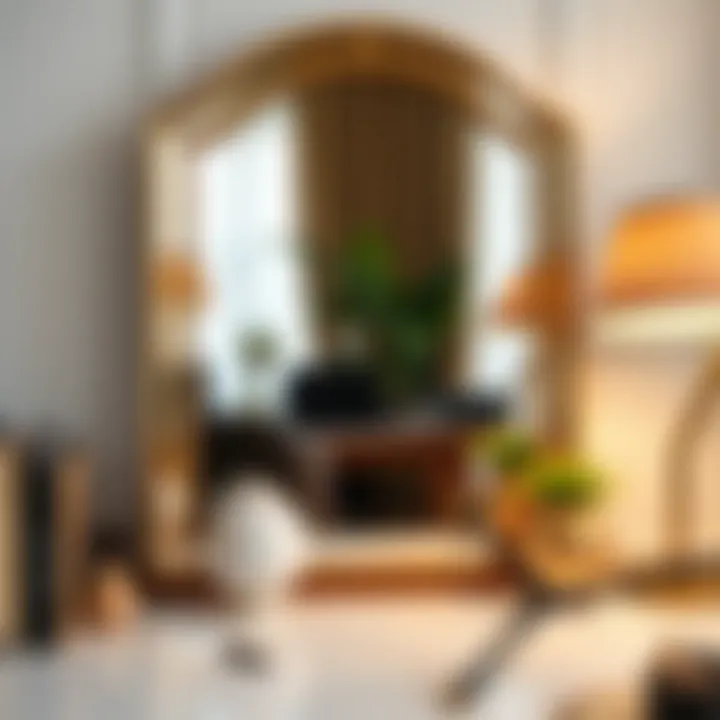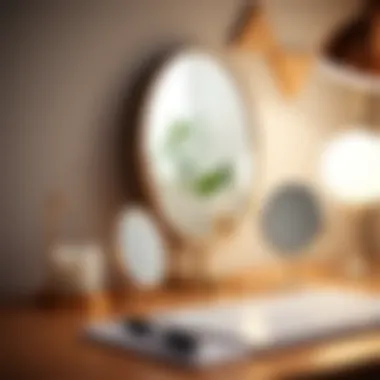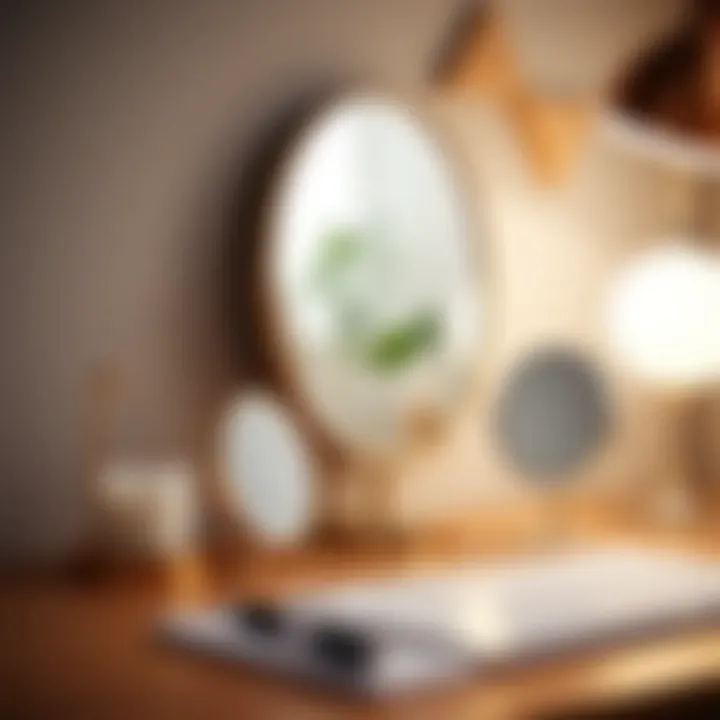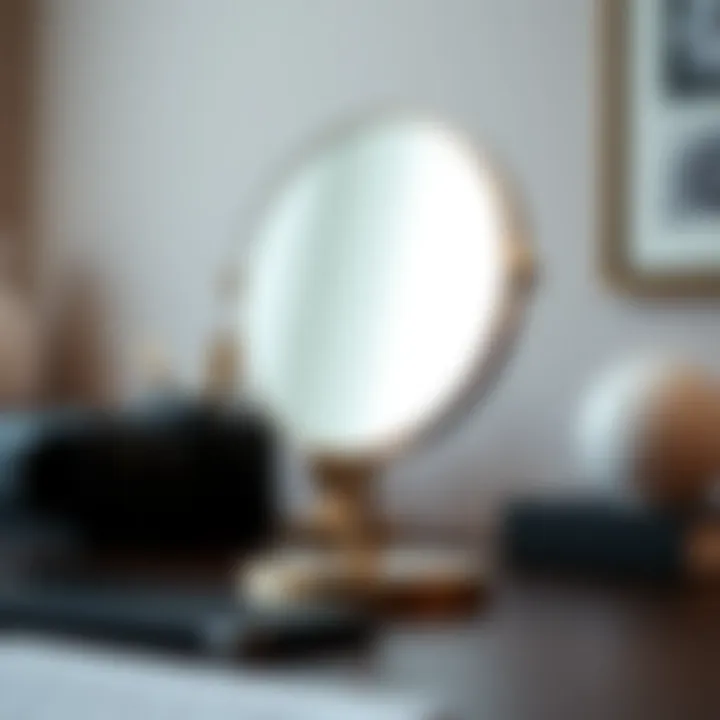Enhancing Workspace Aesthetics with Small Desk Mirrors


Intro
In today’s fast-paced world, where workspaces often blend seamlessly into our homes, the choice of decor plays a pivotal role. One underrated but impactful element in this realm is the small desk mirror. These mirrors are not merely functional items; they serve as dual-purpose pieces that marry style with practicality. They can enhance a desk's overall look while providing a quick glimpse for personal grooming or checking one’s appearance before heading into a meeting or video call.
Moreover, the presence of mirrors carries psychological benefits, creating an enhanced sense of space and light within a workspace. An ideal small desk mirror not only complements your workspace design but also adds a layer of sophistication and intentionality that can boost productivity and creativity.
In the sections that follow, we will explore the Furniture Design Trends that shape the incorporation of small mirrors into contemporary office environments, provide Practical Tips for Furniture Selection, and delve into how these adhesive reflections contribute to a more inviting and effective workspace.
Furniture Design Trends
Trending Materials and Textures
When it comes to selecting a small mirror for your desk, the materials and textures matter a great deal. Contemporary designs often favor a mixture of metals like brass and matte black finishes. These materials are not only durable but also provide a sleek look that elevates the entire desk setup.
Moreover, wooden frames—especially those made from reclaimed wood—add a touch of warmth and uniqueness, bringing natural elements indoors. Glass surfaces, often with interesting textures or colored tints, can enhance the reflective quality without overwhelming the simplicity of the design. Combining these various textures creates a tactile symphony that can make your work desk feel alive.
Color Palettes and Styles
The color palette you choose for your small desk mirror should harmonize with your overall workspace theme. Soft pastels can invoke a calming atmosphere, making them perfect for creative environments, while bold colors could energize a corporate setting. For instance, an airy, light-gray frame can offer a modern and minimalist aesthetic, whereas a vibrant red can inject some character into a more neutral workspace.
In terms of styles, the mirror’s design should either complement or contrast with other elements on the desk. A round mirror can soften the angles of a rigid desk setup, while a rectangular one might add to a more traditional or stately decor. Ultimately, selecting the right combination here can speak volumes about your design preferences and work ethos.
Practical Tips for Furniture Selection
Assessing Space and Functionality
Before deciding on a small desk mirror, assessing the space is crucial. Take measurements and consider the mirror’s role—whether as a functional item for quick checks or as a decorative piece that contributes to the aesthetic appeal of the room. Also, ponder its placement. Is there enough wall space, or does the desk have ample surface area? Positioning a mirror can significantly affect light reflection and the room’s overall flow.
Balancing Aesthetics with Comfort
While aesthetics play a vital role, don’t forget about comfort. A mirror should not interfere with your workspace ergonomics. For instance, ensure that it’s not positioned in a way that causes glare on your computer screen, as this can become a nuisance during long working hours. Additionally, the mirror's size should not overpower your desk surface but rather accumulate harmony among your work essentials.
Ultimately, the careful integration of a small desk mirror can uplift your workspace in both form and function, cultivating an environment that is both stylish and productive.
Prolusion to Small Mirrors
Small mirrors serve as more than just reflective surfaces; they hold the potential to transform workspaces both practically and aesthetically. In today’s fast-paced world, where home offices and study areas are becoming increasingly common, integrating small mirrors into desk arrangements can provide a blend of functionality and style that enhances productivity and mental clarity. They allow for quick self-checks before an important video call, while also elevating the overall look of the workspace.
Understanding what small mirrors are and their historical context sheds light on how they have evolved from simple tools into versatile decor elements. These mirrors come in various shapes and sizes, each offering unique capabilities that cater to the diverse needs of users.
In this section, we delve into essential definitions, historical perspectives, and the myriad uses of small mirrors, laying the groundwork for a more in-depth exploration of their practical benefits and aesthetic contributions.
Defining Small Mirrors
Small mirrors can be defined as reflective surfaces typically measuring no more than two feet in either dimension. Unlike their larger counterparts that dominate spaces, small mirrors are designed to fit comfortably on desks, vanity tables, or even shelves. Their compactness is what makes them adaptable to different environments, whether it be for a quick glimpse before heading into a meeting or as a simple design feature.
These mirrors come in various styles, such as freestanding, wall-mounted, and tabletop variations. Each type serves distinct purposes, contributing to the organization and design coherence of a workspace. In essence, the utility of small mirrors lies in their ability to merge function with aesthetics, making them handy accessories in both personal and professional environments.
Historical Context and Usage
The use of mirrors dates back thousands of years, with some of the earliest examples made from polished stone or metal. As society advanced, so did the materials and techniques used to create mirrors. By the Renaissance period, glass mirrors had become widespread in Europe, not only used in homes but also symbolizing status and wealth.
In modern times, small mirrors have found their way into everyday spaces, gaining popularity in home decor and among designers looking to create engaging interiors.
Historically, mirrors have served multiple purposes:
- Functional Uses: Quick self-assessments and grooming, especially for those in professional environments.
- Decorative Roles: Enhancing the spatial dynamics of a room by creating illusions of depth and light.
- Cultural Significance: In many cultures, mirrors are seen as bad luck or as tools for self-awareness and reflection, adding a layer of fascination to their continued popularity.
Overall, small mirrors’ diverse lineage and their evolution into common fixtures reveal a fascinating story about their utility and aesthetic value. Their adaptability across times and cultures positions them as a relevant topic for anyone looking to tweak their home or workspace design.
Practical Benefits of Small Mirrors
In the hustle and bustle of daily life, it’s crucial to optimize your workspace, and small mirrors can play a significant role in that regard. Not just for checking one's reflection, these mirrors enhance functionality while adding a layer of style. By strategically integrating small mirrors into desk arrangements, one can enjoy various benefits that promote better organization, productivity, and a well-structured environment.
Enhanced Workspace Functionality
Self-checks and grooming
A small mirror on your desk serves as an easy solution for quick self-checks. Whether it’s ensuring your hair is in place or your tie is adjusted just right, having that instant reflection within reach saves time. This convenience is especially valuable during busy mornings when you need to look presentable without the hassle of running to the bathroom.
One of the key characteristics of a desk mirror is its size. Compact enough to sit comfortably in a workspace but large enough for proper visibility, these mirrors allow for a seamless grooming routine. They act as a practical tool that can be easily maneuvered around your workspace as needed. However, it’s essential to choose a mirror that doesn’t take up too much precious desk real estate.
Spatial perception and light reflection
Small mirrors have the unique ability to alter how we perceive our space. Positioned right, they can create an illusion of a larger working area. This effect is particularly noticeable in smaller office setups or intimate home workspaces where every inch counts. A well-placed mirror can bounce light around, enhancing the brightness and overall ambiance of the room.
The reflective quality of these mirrors is not just about aesthetics; it’s about functionality. By optimizing light flow, they help in minimizing eye strain and the need for excessive artificial lighting. While using mirrors for light reinforcement can be beneficial, it’s also wise to be mindful of glare that might come from specific angles.
Reinforcement of organization methods
Mirrors can serve an unexpected role in organization. The strategic placement of a small mirror can reflect organizational tools, helping visualize the overall desk layout and its functionality. It encourages one to maintain a tidy workspace since clutter is easily spotted in reflection.
Additionally, the psychological aspect of seeing a well-organized area reinforces good habits. Striving to keep everything in order becomes easier when it’s reflected back at you. Each glance can remind you of what needs tidying, therefore continually promoting organization without demanding much effort.
Boosting Productivity
Psychological effects of clarity
The clarity provided by small mirrors contributes significantly to mental focus and productivity. A clear reflection symbolizes order and is often linked to a mental state of clarity. When a workspace is nicely managed, it can ward off distractions and encourage a deeper level of concentration.


It’s fascinating how something as simple as a mirror can affect your mood and focus. A neat reflection reminds users that they can maintain a sense of control over their surroundings, providing motivation that potentially boosts overall work performance. However, it is vital to regularly assess your workspace to ensure it reflects the efficiency you aim for.
Mirrors as motivational tools
Mirrors can be surprisingly motivational; they become a source of inspiration through reflection. Whether it’s displaying a motivational quote or a picture of loved ones, the mirror serves as a reminder of personal goals and aspirations. This subtle reinforcement can prompt individuals to stay on track while working.
The unique feature of mirrors as motivational tools is their adaptability. They can be customized to include personal touches that resonate. However, they can also become a distraction if too much attention is drawn away from the work at hand.
Creating a personal aesthetic
Incorporating a small mirror into your desk design allows you to express individual style, transforming an ordinary workspace into a personal sanctuary. Once you choose a mirror that aligns with your taste, it not only serves a utility purpose but also augments the overall aesthetic of your environment.
This personalization can foster a sense of ownership, making one more inclined to spend time at the desk. However, it’s essential to strike a balance between style and function. An over-decorated mirror may lead to clutter, thus detracting from the tranquil work setting you aim to create.
"The beauty of small mirrors lies not just in their reflections but in their ability to shape our spaces and elevate our productivity."
Their practical benefits extend beyond mere appearances, offering gears that help in the overall machinery of ideal workspace configuration. With thoughtful introduction into one's desk layout, small mirrors can magnify both utility and beauty effectively.
Aesthetic Contributions
The aesthetic impact of small mirrors on desks cannot be overstated. They are not merely functional objects; they are integral components that enhance the visual landscape of a workspace. The right mirror can act as a focal point, drawing in the eye and providing balance to various design elements present on the desk. This section elucidates how small mirrors contribute to the overall aesthetic of your workspace, addressing both design integration and the role of color and reflection.
Design Integration
Complementing different interior styles
Small mirrors serve as versatile design elements, able to fit seamlessly into varied interior styles. Whether your workspace leans toward minimalism, bohemian, or industrial charm, a well-chosen mirror can tie the entire look together.
- Key Characteristic: Mirrors reflect not just light, but also the overarching theme of the room. For instance, a vintage-styled mirror can add a nostalgic touch to an otherwise modern aesthetic.
- Benefits: By complementing the existing decor, mirrors enhance the overall harmony. They bring a sense of completeness into the design, making spaces feel cohesive and well-thought-out.
- Unique Features: The shapes and finishes of mirrors can vary significantly. Some may feature ornate frames that echo historical aesthetics, while others might be sleek and frameless, aligning with contemporary tastes.
Above all, choosing a mirror that speaks to your style can elevate a simple desk setup into a thoughtful design statement.
Mirrors as decorative accents
When considering small mirrors, their function as decorative accents adds a layer of depth to workspace aesthetics. They can serve both practical and decorative purposes, creating a layered visual experience on a desk.
- Key Characteristic: The reflective quality of mirrors interacts uniquely with light and surrounding colors. This makes them excellent choices for accentuating features such as artwork or plants nearby.
- Benefits: Using mirrors as accents can create a dynamic look, making the workspace feel larger while breaking the monotony of desk accessories. They can also act as conversation starters, sparking interest and enhancing creativity.
- Unique Features: Decorative mirrors come in an array of styles—from geometric shapes to whimsical designs—each contributing a distinct personality to the space.
This dual role of small mirrors—functional yet decorative—can significantly elevate the ambiance of a workspace, making it not just a place for work but a personal retreat that reflects individuality.
Color and Reflection
Influencing perceived color schemes
Mirrors play an instrumental role in shaping how color is perceived in the workspace. Their reflective surfaces can amplify or soften existing color palettes, thereby affecting the mood of the environment.
- Key Characteristic: A mirror's ability to reflect colors opens up possibilities for experimenting with bold hues without overwhelming a space.
- Benefits: In smaller workspaces, this manipulation of colors can make environments appear more spacious and lighter—an advantage when working with limited square footage.
- Unique Features: Depending on their placement, mirrors can reflect different elements, enhancing colors from nearby decor and potentially transforming how those colors are experienced.
Light enhancement in dark spaces
In dimly lit offices or home setups, small mirrors can be game-changers, enhancing available light and creating a more inviting atmosphere.
- Key Characteristic: By strategically positioning mirrors, one can bounce natural or artificial light around, providing brighter conditions conducive to productivity.
- Benefits: This illumination not only uplifts the aesthetic but contributes positively to mood and efficiency, making working conditions more pleasant.
- Unique Features: The reflection of light creates an illusion of depth, drawing the eye in and rendering compact spaces feel larger and more welcoming.
In sum, small mirrors are not merely for checking one’s appearance. Their aesthetic contributions embrace a great balance of form and function, impacting the mood and style of a workspace in ways that go beyond initial perceptions.
Types of Small Mirrors for Desks
Small mirrors serve varied purposes beyond mere reflection. When it comes to desks, their types can greatly influence both functionality and style. Understanding the different types available can help you make an informed choice that not only complements your workspace but also serves specific needs effectively.
Freestanding Mirrors
Mobility versus stability
The debate of mobility versus stability is crucial when choosing freestanding mirrors. A mobile mirror can be effortlessly moved across your desk, permitting you to adjust angles based on natural light or your sitting position. This flexibility makes it a popular option among those who like to change their setup frequently. On the flip side, while stability is a benefit, it can come at the cost of bulkiness. A larger freestanding mirror might provide a better reflection but can limit your desk's available space, complicating organization.
Style variations
Freestanding mirrors offer an array of styles that can easily align with various desk aesthetics, whether modern, rustic, or minimalist. These mirrors can be seen in intricate vintage frames or sleek contemporary designs, allowing for a personalized touch. However, a drawback of opting for style over function can sometimes lead to choosing a design that doesn't integrate seamlessly with other desk elements. Therefore, balancing your aesthetic preference with practicality is key here.
Wall-mounted Mirrors
Space-saving advantages
Wall-mounted mirrors are primarily favored for their ability to save precious desk space. By utilizing vertical space, they ensure that every inch of your surface area is available for productive use. This is especially important in smaller workspaces where clutter can become overwhelming. However, these mirrors can sometimes restrict your ability to reposition them, which might be a concern if you like to change your decor frequently or rearrange your workspace.
Placement recommendations
Placement is pivotal for wall-mounted mirrors. Ideally, they should be positioned at eye level for the best reflection. Installing them too high or too low can result in awkward angles, which detract from their usefulness. While this method helps optimize space, it may require some planning to get right. Also, take care not to place them directly opposite windows, as glare could impede their function.
Tabletop Mirrors
Size considerations
When opting for tabletop mirrors, size is a major factor. A mirror that’s too large can overpower the desk, while one that’s too small might not serve its intended purpose effectively. The right size allows for easy visibility without encroaching on other items. Many prefer a compact mirror that fits neatly in a corner without causing distractions. However, adjusting to size may also require a trade-off between visibility and desk organization, depending on other tools or workspace elements you have on hand.
Material choices
Materials play a fundamental role in the durability and overall aesthetic of tabletop mirrors. Common choices include glass and acrylic, each with distinct advantages. Glass mirrors provide clarity but need careful handling to avoid breakage. On the other side, acrylic mirrors are lightweight and resistant to shattering but may not offer the same reflective quality. The choice depends on personal preference and the intended usage within the workspace.


Selection Criteria
Selecting the right small mirror for your desk is not just about picking something that looks nice. It's a decision that can influence both aesthetics and functionality in your workspace. The following criteria should be carefully considered to ensure that you choose a mirror that enhances your environment and meets your needs effectively.
Material Options
Glass versus acrylic
When choosing a material for a small mirror, the glass and acrylic options stand out distinctly. Glass mirrors are renowned for their clarity and reflective quality, giving such surfaces an edge when it comes to creating crisp images. A major upside is that they usually have a longer life span than their acrylic counterparts, making them a more durable investment.
On the flip side, acrylic mirrors are lightweight and shatter-resistant, which is a great advantage for those concerned about safety. They also come in various styles and can be more affordable than glass. However, one trade-off to keep in mind is that acrylic may scratch easier and can lead to less precise reflections compared to glass.
"Your choice of material can make or break the way the mirror will influence the space."
Durability and ease of cleaning
Durability is essential when it comes to selecting desk mirrors. Glass mirrors hold up well against wear and tear but require cautious handling to avoid breakage. Regular cleaning typically involves gentle glass cleaners that do not scratch the surface, keeping them pristine for years.
Conversely, acrylic mirrors offer an easy-care option. They can generally endure rough cleaning without risk of breaking, making them ideal for busy workspaces. However, potential users must be mindful of its susceptibility to scratching which may require less aggressive cleaning methods.
Size and Proportions
Evaluating available desk space
Before committing to a particular mirror, assessing your available desk space is crucial. An oversized mirror can appear overwhelming and disrupt the balance of your workspace, while one that’s too small might lack utility and visual impact. Measure your desk area to find a proportional mirror that serves its function without cluttering the surface.
In this case, a mirror that complements desk dimensions can help create an inviting atmosphere and keeps your desk organized. This balance can enhance productivity as it minimizes distraction and optimizes focus.
Balancing functionality and style
Next up is balancing functionality and style. The mirror shouldn't just be a pretty face; it’s got to work for you too. A functional mirror allows you to perform quick checks before stepping into meetings, while style reflects your personal brand. Look for one that achieves both goals without compromising too much on either.
Different designs also offer various functionalities, such as adjustable angles or built-in lighting, melding utility with a chic appeal. A polished finish can elevate your workspace, making it more professional and personal, this is especially important in environments where aesthetics represent your work ethic.
Style and Finish
Modern versus traditional aesthetics
Consider how a mirror can blend seamlessly with your decor style, whether it’s modern or traditional. Modern aesthetics usually lean toward sleek, geometric shapes with minimalistic finishes, which can invoke a sense of order and clarity.
Traditional styles, however, often feature ornate designs and rich materials, adding warmth and character to your space. Each aesthetic choice contributes uniquely to the overall vibe of your workspace, making it a critical aspect of selection.
Finishes that complement surrounding decor
Finally, the finish of your mirror should enhance the decor around it. A matte finish might seamlessly integrate into a rustic design, while a glossy finish may serve better in a contemporary setting. The color and texture of the mirror's surface interact with the surrounding elements, highlighting or contrasting with the decor.
A thoughtfully chosen finish can make the mirror not just a tool but a centerpiece, adding a touch of elegance or sophistication to the overall look of the workspace, ensuring it feels unified and inviting.
Optimal Placement Strategies
Placement of small mirrors on desks is about more than just function; it’s a strategic dance that balances light, space, and style. The right placement can turn a simple mirror into a feature that enhances both the utility of the workspace and its aesthetics. Understanding the nuances of optimal placement can transform how one interacts with their environment, turning what may seem like an accessory into a pivotal design element.
Positioning for Light
Maximizing natural light
Natural light has a certain charm. When positioned to catch the sunlight streaming through a window, a small mirror can amplify this illumination. It reflects light, brightening darker corners and creating an open feeling. This aspect of maximizing natural light is crucial as it not only enhances visibility but also nurtures a warmer atmosphere.
Why is this technique so popular? One key characteristic is its ability to create an inviting ambiance. The natural glow combined with mirrored reflections can make a workspace feel less confining. Imagine a calm morning, soft rays filtering through, and your desk is alive with soft light bouncing around—it's a breath of fresh air.
The only downside? Over-reliance on this strategy might lead to glare, which can be distracting. Thus, it's a balancing act—positioning your mirror just right can yield significant dividends in overall workspace satisfaction while avoiding any unwelcome distractions.
Artificial lighting effects
In settings where natural light is scarce, artificial lighting becomes essential. Here, mirrors can serve a dual purpose: as tools for illumination and as aesthetic objects. Placed strategically, a small mirror can reflect light from lamps or overhead fixtures, enhancing brightness throughout the workspace. This aspect is vital when you consider the needs of individuals who work late into the night or in facilities without ample daylight.
One big plus of utilizing artificial lighting effects is the flexibility it brings to design. Want a pop of glamour? Mount a mirror near a stylish lamp to create a unique reflection that adds depth to any decor. Conversely, a misaligned mirror can produce unflattering light angles, sometimes leading to awkward reflections. Managing these artificial light sources can bring clarity and warmth to the workspace.
Creating Visual Balance
Symmetrical vs. asymmetrical arrangements
Creating a visually balanced workspace often delves into the territory of symmetry and asymmetry. Symmetrical arrangements resonate with a sense of order and formality—think of two matching small mirrors flanking each side of a desk. This layout promotes stability and can be pleasing to the eye. In contrast, an asymmetrical composition, perhaps placing one mirror among various desk artifacts, introduces dynamism and creativity.
Among these two styles, symmetrical arrangements offer a timeless appeal; they’re beneficial for fostering a calming environment. However, asymmetry adds a layer of complexity and personality that can inspire creativity—each choice has advantages and disadvantages depending on individual preference.
Integrating with other desk accessories
A mirror doesn’t have to stand alone on a desk. Integrating it with other accessories can elevate the entire aesthetic. A small mirror can complement devices, planners, or plants. Successful integration can enhance functionality, as the mirrored surface might help check appearance or create a whimsical focal point.
Choosing the right accessories to accompany your mirror is essential. Ideal partners might be a chic lamp or a stylish pencil holder. On the flip side, overloading the desk with too many objects can distract from the mirror’s presence, diminishing its appeal. Thus, curating a balanced setup not only enhances visual appeal but strengthens the overall function of the desk as a workspace.
Psychological Considerations
Creating a workspace that fosters productivity goes beyond the mere physical aspects; it encompasses psychological factors as well. Small mirrors, strategically placed, can significantly influence an individual's mood and focus. Regarding remote work and home offices, the spaces we've curated speak volumes about us. Not just a reflection in a literal sense, these mirrors echo personal identities and help in setting a productive tone for the day.
Impact on Mood and Focus
Reflections of personal style and identity


The reflections of personal style and identity hinge on how an individual decorates their workspace. A small mirror can be a silent partner in defining not only the style but also the user’s identity. When one glances at a decorative mirror, it often resonates with their taste, creating a sense of belonging. This connection can lead to an enhancement in mood as individuals feel more at ease in their environment. An inviting style boosts self-esteem, allowing creativity to flow more freely. The ability to personalize a workspace results in an atmosphere that feels uniquely their own.
However, this can set a double-edged sword. While personalization is uplifting, over-cluttering with mirrors or accessories can cause visual confusion. Balancing between personal touch and functional clutter should be a priority.
Mirrors as a tool for self-awareness
Using mirrors as a tool for self-awareness plays a pivotal role in personal development. When placed in a workspace, mirrors encourage self-reflection not just physically but also metaphorically. They can cultivate an environment where individuals pause to evaluate their work and mindset. Having that reflective surface helps create a space for introspection. It can remind one to take a breather in stressful moments.
While beneficial, continuous self-assessment can potentially lead to overthinking. This aspect might stall productivity in a fast-paced environment. Therefore, the strategic placement is key—helping to reap the benefits of self-awareness without falling into the trap of self-critique.
Creating a Inviting Environment
Psychological effects of space openness
Psychological effects of space openness do not just affect mood; they amplify productivity. Small mirrors can create the illusion of a more expansive area, even in tight spots. When reflections are introduced, they can trick the eye into perceiving greater depth, making spaces appear less confined. This immersive sensory experience can lead to feelings of freedom and relaxation, enhancing focus and drive.
Moreover, such openness may lead to increased collaboration and idea-sharing within workspaces, as occupants feel less isolated. Still, excessive mirroring might yield the opposite—too many reflections can create chaos in perception rather than clarity. Observations between openness and crammed placements should be paramount in creating the ideal desk environment.
Using mirrors to reduce clutter perception
Using mirrors to reduce clutter perception offers noteworthy advantages. Reflective surfaces can overshadow perceived disorganization by creating a visual illusion of more space. This psychological nudge can lead to more efficient workflow and enhanced clarity. A tidy appearance can foster feelings of accomplishment, promoting productivity in any workspace.
However, the effectiveness of making a space seem less cluttered can diminish if mirrors are improperly placed. If positioned incorrectly, mirrors themselves can contribute to visual clutter rather than alleviating it. Therefore, mindful placement is essential in reaping the advantages of using mirrors to counteract the burden of clutter.
"The mind is where clutter overtakes clarity; mirrors can be a simple remedy to that mental disorder."
Maintenance and Care
The upkeep of small mirrors on desks is not just about appearance but is essential to maintain their functionality and aesthetic appeal. Regular cleaning and careful positioning help avoid wear and tear, ensuring that these mirrors serve their purpose effectively. When adequately maintained, mirrors enhance the overall ambiance of the workspace, offering both practical benefits and visual reinforcement.
Cleaning Techniques
Safe cleaning products
Using safe cleaning products is crucial for maintaining small mirrors. Common glass cleaners can contain ammonia or harsh chemicals that may leave streaks or damage the reflective surface over time. Instead, consider solutions like vinegar mixed with water or gentle dish soap diluted in water. These household items are non-toxic, making them a popular choice for many.
Here are some highlights of safe cleaning products for desk mirrors:
- Eco-Friendly Options: Many safe products are biodegradable, contributing to an environmentally conscious lifestyle.
- Non-Toxic Ingredients: Without harsh chemicals, these options are safer, especially in home offices where pets or children are present.
The main advantage of using safe cleaning products is their gentle nature, which protects the mirror’s finish while effectively removing smudges. However, be wary that some natural solutions may require more elbow grease compared to commercial cleaners.
Frequency of maintenance
In terms of frequency, keeping a consistent cleaning schedule is vital. It’s best practice to clean your mirror at least once a week, especially in high-use areas. This frequency helps prevent buildup from dust, fingerprints, and light smudges, which can diminish the reflective quality over time.
Consider these points regarding maintenance frequency:
- Establishment of Routine: Incorporating cleaning into a weekly routine fosters good habits and prevents neglect.
- Visual Clarity Maintenance: Regular attention keeps mirrors looking their best, enhancing the workspace’s visual appeal.
The unique feature here is establishing a habit. Once cleaning becomes part of your workflow, the effort required lessens, making it easier to maintain a pristine setup. Neglecting frequent care, however, can lead to larger cleaning jobs that can be quite cumbersome.
Position Management
Adjusting for different uses
Various adjustments are needed depending on the specific uses of the mirror. When setting it up, consider how often you’ll need to check your appearance versus its role as a decorative element. You might find that tilting the mirror slightly could optimize both functions. It’s instrumental to ensure that it works well in tandem with your desktop activities, whether for grooming or as a source of light reflection.
This adjustment aspect is beneficial because it allows personalized usage based on preference. For example, mirrors positioned for makeup checks might need different angles compared to those used for simply enhancing light in a dim workspace.
Protecting from sun damage
Even in the most aesthetic setups, protecting mirrors from direct sunlight can extend their life considerably. Sun damage can lead to fading of the reflections over time or even make the frame warp. This concern becomes essential, especially for wood or plastic frames that may degrade under prolonged exposure.
A noteworthy feature of sun protection includes:
- Placement Considerations: If placed near windows, shades or curtains might be necessary to control sun exposure.
- Seasonal Adjustments: In seasons with high sun, it may be needed to reconsider the mirror’s position altogether.
The advantage of careful positioning comes from prolonging functionality and beauty. Yet, it requires vigilance - it's easy to forget about sun angles as seasons change.
Maintaining small mirrors should be seen as a holistic approach. The effort spent on cleaning and positioning can yield a workspace that not only serves its practical needs but also provides an inviting aesthetic.
Final Thoughts
As we wrap up this exploration into the world of small mirrors for desks, it becomes clearer that their role transcends mere functionality. These simple objects blend utility with aesthetics, enriching not just workspaces but the overall experience of our daily tasks. Mirrors offer a unique ability to serve practical needs while also functioning as design statements—a duality that is increasingly relevant in modern workspace design.
Balancing Functionality and Artistry
When choosing small mirrors, the balance between functionality and artistry plays a crucial role. A well-placed mirror can enhance a workspace by providing not just a tool for self-checks but also an element of visual interest. For example, selecting a mirror with an ornate frame can add a touch of elegance, while a sleek, minimalist design could cater to a more modern aesthetic. Such choices actually reflect personal style and contribute to creating a cohesive environment.
Here are a few key points to consider:
- Functionality First: Ensure that the size and type of mirror you choose serve your practical needs—whether it’s for quick grooming checks or enhancing light in your workspace.
- Artistic Expression: Opt for designs that resonate with your personal taste. This could be through color, shape, or frame style.
- Context Matters: The mirror’s presence should enhance, not distract from, the functionality of your workspace. A well-integrated mirror will complement surrounding elements and not overpower them.
Demonstrating this balance not only fine-tunes the workspace but also cultivates a more thoughtful environment, where functionality and artistry exist hand-in-hand.
Encouraging Personalization of Workspaces
Personalization is at the heart of creating a workspace that feels individually tailored. Small mirrors serve as versatile tools in this quest. Their ability to reflect light and surroundings allows for creative incorporation into desk setups that align with individual preferences.
Consider these elements when personalizing your workspace with mirrors:
- Reflecting Identity: Choose mirrors that resonate with your personal style or interests. For instance, a vintage mirror can reflect one’s love for classic decor, while a modern geometric piece might speak to a contemporary sensibility.
- Creative Placement: Don't shy away from trying unexpected mirror placements. Layering different mirror styles or using them at unique angles can redefine the space.
- Functional Decor: Use mirrors that offer added benefits, like maximizing your desk’s natural light or helping organize your work materials.
Involving mirrors in your workspace personalization journey can serve as a form of self-expression, elevating the mundane into the exceptional. As you strategically place these reflective surfaces, remember that each decision reinforces your identity within the workspace, making it distinctly yours.
Ultimately, integrating small mirrors thoughtfully can lead to a workplace that not only serves its purpose but also enhances the very essence of who you are.



